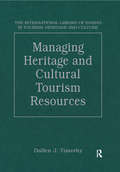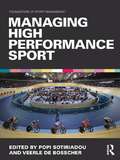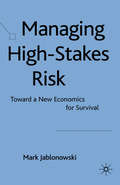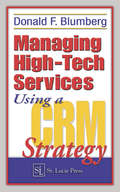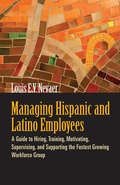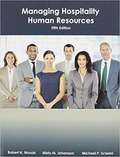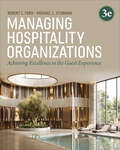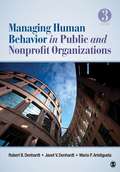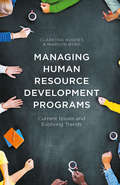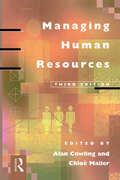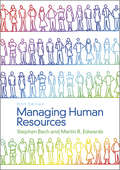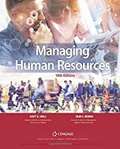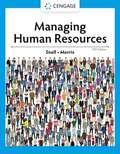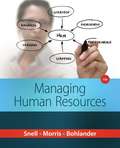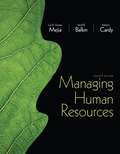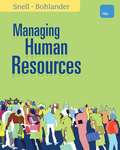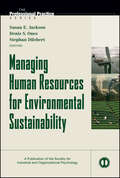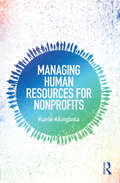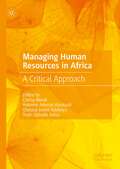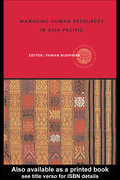- Table View
- List View
Managing Heritage and Cultural Tourism Resources: Critical Essays, Volume One (The International Library of Essays in Tourism, Heritage and Culture)
by Dallen J TimothyThis three volume reference series provides an authoritative and comprehensive set of volumes collecting together the most influential articles and papers on tourism, heritage and culture. The papers have been selected and introduced by Dallen Timothy, one of the leading international scholars in tourism research. The first volume 'Managing Heritage and Cultural Tourism Resources' deals primarily with issues of conservation, interpretation, impacts of tourism and the management of those impacts. Sold individually and as a set, this series will prove an essential reference work for scholars and students in geography, tourism and heritage studies, cultural studies and beyond.
Managing High Performance Sport (Foundations of Sport Management)
by Popi Sotiriadou Veerle De BosscherHow can managers design and implement effective high performance programmes in sport? What are the key challenges in managing elite athletes, sports people and teams? This is the first book to provide a comprehensive introduction to management practice, process and policy in elite and high performance sport (HPS). Drawing on real-world case-studies of elite sport around the world, the book shows a conceptual framework for studying and analysing high performance sport and introduces the skills and techniques that managers and administrators will need to develop effective HPS programmes. The book examines the macro level factors that determine a nation’s sporting success, including political, social and cultural elements, and then moves on to unpack the specifics of elite athlete and team management at a micro level. Adopting an integrated, holistic approach throughout, the book highlights best practice in every key area of an HPS programme, including: defining performance and success organizational structure and leadership finance, funding and marketing coaching and coach development talent identification and development competition and events training and facilities scientific research and sport science support. The book features contributions from world-leading sport management academics as well as practitioners with experience of managing HPS programmes at world and Olympic level. Each chapter includes a full range of useful features, such as summaries, case-studies, review questions and guides to further reading. This is essential reading for all serious students and professionals working in sport management or high performance sport.
Managing High-Stakes Risk
by Mark JablonowskiThe threat we face from high-stakes risk has never been higher. These challenges include environmental pollution, fragile financial systems and the threat of widespread geopolitical violence. This book suggests that a return to natural risk levels - those in accordance with naturally occurring background levels - is both desirable and achievable.
Managing High-Tech Services Using a CRM Strategy
by Donald F. BlumbergAs high-tech service industries grow more competitive, the need to develop customer focused business strategies becomes imperative. Managing High-Tech Services Using a CRM Strategy explores how to manage and direct any service organization utilizing a high tech strategy supported by the Customer Relationship Management (CRM) infrastructure, enablin
Managing Hispanic and Latino Employees: A Guide to Hiring, Training, Motivating, Supervising, and Supporting the Fastest Growing Workforce Group
by Louis NevaerThe first book on supporting and developing Hispanic employees in any organization Identifies three overarching concepts that shape Hispanic culture and explores how they influence workplace behavior and expectations Written by a distinguished Hispanic author and authority on Hispanic economic behavior Hispanics are the largest minority group and the fastest growing demographic in the United States—they are already 15% of the population and 22% of the workforce, and it’s estimated that by 2050 those numbers will go up to 36% and 55% In this much-needed new book Louis Naevar helps non-Hispanic employers and colleagues understand how Hispanics see the business world—and the world in general—so they can better support and develop this dynamic group of workers. Drawing on his own ethnic background and years of experience as director of the organization Hispanic Economics, Nevaer identifies three concepts that shape Hispanic culture and often result in behaviors and beliefs very different than, and sometimes seemingly at odds with, those of non-Hispanics. He explores subtle nuances within the Hispanic community—which is no more monolithic than the “European” community—that will help employers appreciate differences and tensions between Hispanic workers. With this as an overarching framework, and using a wealth of specific examples, Nevaer shows how to develop Hispanic-friendly approaches in every aspect of the modern workplace, from recruitment, retention and evaluation to training, mentoring, and labor relations. As Hispanics become an ever-larger segment of the workforce, organizations who fail to make them feel welcome and valued risk losing access to a significant source of talent and innovation, not to mention a connection to a major evolving market. Managing Hispanic and Latino Employees is an invaluable resource for creating an environment where Hispanic workers feel comfortable, recognized and rewarded.
Managing Hospitality Experiences
by Peter Cox Josephine Pryce Alexandra Kenyon Ade Oriade Roya Rahimi Dr Peter Robinson Adenike Adebayo Rudin Beka Kevan Burke Sandra J Cooper Martin Hilton James Musgrave Lucy Hack Gonzalo Díaz MenesesManaging hospitality experiences is a crucial part of the hospitality business and industry alike. While many textbooks cover the management of hospitality services, this text focuses specifically on experiences, while also providing a full and detailed insight into the ways in which experiences are designed and delivered. Using examples from the gamut of hospitality, this book explores issues around people, services and spaces. It covers management issues such as marketing, human resources, operations, quality management, facilities management, project management and strategy, while considering hospitality operations within their wider geo-social and geo-environmental settings. This book includes a range of important contemporary topics, such as sustainability, resilience and ethics; supported throughout by learning objectives, case studies, review questions, links to videos and further reading suggestions. This book: Emphasises experiences within hospitality, providing students with a focused and applicable text. Includes numerous international industry case studies to illustrate how hospitality organisations manage experiences; these real-life scenarios provide key teaching points. Provides wider theoretical principles to develop the field of hospitality and place it within an industry context. An invaluable read for undergraduate students of hospitality and event management, this textbook also provides an overview for postgraduate students and those studying further education courses in hospitality and related areas.
Managing Hospitality Human Resources
by Robert Woods<p>HUMAN resources is an ever-changing field. Keeping up with it is mandatory for hospitality business leaders for a variety of reasons, including remaining in compliance with government regulations and developing an effective hospitality service organization. <p>When the first edition of Managing Hospitality Human Resources came out in 1994, there were real reasons for the hospitality industry to worry about having enough employees in the future. During the 1990s, hospitality suffered from a shortage of employees, high turnover rates, and image issues in some areas. By the late 2000s the turnover issue had been mostly addressed, although the potential for recurrence of the problem still persists. Hospitality's image has been greatly repaired from the days of the Resolution Trust Corporation in 1989 and similarly troubled organizations in the years after, when many hotels were auctioned off after hundreds of savings and loan organizations failed. The industry became much leaner, and stayed lean due in part to the Great Recession, which officially began in December of 2007. Hospitality organizations today are pretty savvy. As a general rule, they stay on top of human resources issues and have developed many new HR programs to improve the hospitality workplace and help end the impression that a hospitality job is a way station in life--an image that has persisted for much of the industry's modern existence.</p>
Managing Hospitality Organizations: Achieving Excellence in the Guest Experience
by Michael C. Sturman Robert C. FordManaging Hospitality Organizations: Achieving Excellence in the Guest Experience takes students on a journey through the evolving service industry. Each chapter focuses on a core principle of hospitality management and is packed with practical advice, examples, and cases from some of the best companies in the service sector. Students will learn invaluable skills for managing the guest experience in today’s ultracompetitive environment. The Second Edition includes new coverage of technology, sustainability, sexual harassment, diversity and inclusion, and ethical leadership.
Managing Hospitality Organizations: Achieving Excellence in the Guest Experience
by Michael C. Sturman Robert C. FordManaging Hospitality Organizations: Achieving Excellence in the Guest Experience takes students on a journey through the evolving service industry. Each chapter focuses on a core principle of hospitality management and is packed with practical advice, examples, and cases from some of the best companies in the service sector. Students will learn invaluable skills for managing the guest experience in today’s ultracompetitive environment. The Second Edition includes new coverage of technology, sustainability, sexual harassment, diversity and inclusion, and ethical leadership.
Managing Hospitality Organizations: Achieving Excellence in the Guest Experience
by Michael C. Sturman Robert C. FordIntroduction to Hospitality Management: Achieving Excellence in the Guest Experience, Third Edition takes students on a journey through the evolving service industry. Each chapter focuses on a core principle of hospitality management and is packed with practical advice, examples, and cases from some of the best companies in the service sector. Authors Robert C. Ford and Michael Sturman emphasize the critical importance of focusing on the guest and creating an unforgettable customer experience. Whether your students will be managing a neighborhood café, a convention center, or a high-end resort hotel, they will learn invaluable skills for managing the guest experience in today’s ultracompetitive environment. Included with this title: LMS Cartridge: Import this title’s instructor resources into your school’s learning management system (LMS) and save time. Don’t use an LMS? You can still access all of the same online resources for this title via the password-protected Instructor Resource Site. Learn more.
Managing Hospitality Organizations: Achieving Excellence in the Guest Experience
by Michael C. Sturman Robert C. FordIntroduction to Hospitality Management: Achieving Excellence in the Guest Experience, Third Edition takes students on a journey through the evolving service industry. Each chapter focuses on a core principle of hospitality management and is packed with practical advice, examples, and cases from some of the best companies in the service sector. Authors Robert C. Ford and Michael Sturman emphasize the critical importance of focusing on the guest and creating an unforgettable customer experience. Whether your students will be managing a neighborhood café, a convention center, or a high-end resort hotel, they will learn invaluable skills for managing the guest experience in today’s ultracompetitive environment. Included with this title: LMS Cartridge: Import this title’s instructor resources into your school’s learning management system (LMS) and save time. Don’t use an LMS? You can still access all of the same online resources for this title via the password-protected Instructor Resource Site. Learn more.
Managing Human Behavior in Public and Nonprofit Organizations
by Robert B. Denhardt Janet V. Denhardt Maria P. AristiguetaThe only text in management and organizational behavior to focus on public organizations, nonprofit organizations, and school systems, Managing Human Behavior in Public and Nonprofit Organizations fosters competency in critical management and leadership skills including communication, motivation, teamwork, group dynamics, and decision-making. Cases, self-assessment exercises, simulations, and evaluative instruments provide students the opportunity to experience the applied side of theories and to learn both cognitively and experientially. The Third Edition covers recent developments in the field including the emergence of "positive organizational behavior. "
Managing Human Resource Development Programs
by Marilyn Y. Byrd Claretha HughesManaging Human Resource Development Programs makes the critical connection between HR development and the larger system of HR management. This book offers a framework for developing HR programs that are customizable to the needs of the organization.
Managing Human Resources
by Alan Cowling Chloe MailerThis is the third edition of a book which has gained wide acceptance in universities and colleges for use on advanced courses in human resource management. Written by a team of recognized experts in thier field, it combines a high academic standard with an applied approach to the challenges facing managers today, which will appeal to both line mangers and human resource managers.
Managing Human Resources
by Martin Edwards Stephen BachThis revised edition is a comprehensive, authoritative set of essays. It is more detailed and analytical than the mainstream treatments of HRM.As in previous editions, Managing Human Resources analyses HRM, the study of work and employment, using an integrated multi-disciplinary approach. The starting point is a recognition that HRM practice and firm performance are influenced by a variety of institutional arrangements that extend beyond the firm. The consequences of HRM need to incorporate analysis of employees and other stakeholders as well as the implications for organizational performance.
Managing Human Resources
by Scott Snell Shad MorrisSnell/Morris/Bohlander's market-leading MANAGING HUMAN RESOURCES builds on a foundation of research and theory with an inviting, practical framework that focuses on critical HR issues and practices. More than 500 memorable examples from a variety of real organizations illustrate key points and connect concepts to current HR practice. Fresh examples throughout the seventeenth edition spotlight the latest developments and critical trends, while hands-on applications focus on practical tips and suggestions. Demonstrating how HR impacts both individuals and organizations, this resource helps students learn to think like managers -- and develop competencies that will enable them to succeed in their future careers.
Managing Human Resources
by Scott Snell Shad MorrisLearn how today's organizations can most effectively compete through their people with Snell and Morris market-leading MANAGING HUMAN RESOURCES, 19E. This inviting, practical framework focuses on critical HR issues and practices, examining the impact of the pandemic on HR. More than 500 current, memorable examples from real organizations illustrate key points, while cases connect concepts to current HR practices. Practical content and applications equip you with the tools and understanding to evaluate current HR challenges and opportunities and positively affect change. You learn how HR impacts individuals and organizations as the latest content examines recent developments, such as the impact of data analytics on HR, concerns of Generation Z and millennial employees and the impact of remote work and social media on HR. Learn to think like an effective manager and develop the competencies to succeed in business today.
Managing Human Resources 17th Edition
by Scott A. Snell George W. Bohlander Shad S. MorrisGain a better understanding of how human resources impacts both individuals and organizations with this market-leading, practical text. Snell/Morris/Bohlander's popular MANAGING HUMAN RESOURCES, 17TH EDITION builds upon a foundation of research and theory with an inviting, practical framework that focuses on today's most critical HR issues and current practices. The book's engaging writing style and strong visual design use more than 500 memorable examples from a variety of real organizations to illustrate key points and connect concepts to current HR practice. Fresh examples spotlight the latest developments and critical trends, while hands-on applications focus on practical tips and suggestions for success.
Managing Human Resources (7th Edition)
by Robert L. Cardy David B. Balkin Luis R. Gomez-MejiaManaging Human Resources prepares all future managers with a business understanding of human resource management skills. The non-functional HR approach used in this text also makes human resources relevant to anyone who has to deal with HR issues, even those who do not hold the title of manager. This edition contains up to 600 new references, a new set of cases that address HR in small businesses, and coverage on the global economic crisis and it's impact on HR.
Managing Human Resources (Sixteenth Edition)
by Scott A. Snell George W. BohlanderGain a better understanding of how human resources impacts both individuals and organizations with this market-leading, practical text. Snell/Bohlander's popular MANAGING HUMAN RESOURCES, 16TH EDITION builds upon a foundation of research and theory with an inviting, practical framework that focuses on today's most critical HR issues and current practices. The book's engaging writing style and strong visual design use more than 500 memorable examples from a variety of real organizations to illustrate key points and connect concepts to current HR practice. Fresh cases spotlight the latest developments and critical trends, while hands-on applications focus on practical tips and suggestions for success.
Managing Human Resources for Environmental Sustainability
by Susan E. Jackson Deniz S. Ones Stephan DilchertBusinesses are being pressured by governments, customers and employees alike to adopt environmentally-friendly policies and practices. This volume describes these trends and examines their implications for scholars and practitioners of human resource management. It explores the macro context that is shaping organizational responses to environmental concerns and includes several case studies that illustrate organizational initiatives that have clear implications for workforce management. The book also presents empirical research that is directly relevant to human resource management for environmentally-friendly organizations. International in scope it reflects concerns of different regions of the world North America, South America, Europe, and Asia.
Managing Human Resources for Nonprofits
by Kunle AkingbolaThe core resources and capabilities of any nonprofit organization lie in their human capital; their knowledge, skills and behaviors are critical to the achievement of the organization's mission and performance. Thus, effective management of this key resource is integral to the nonprofit organization's success. This book focuses on the unique characteristics, challenges and contribution of human resource management to the strategic objectives of the nonprofit. It explores contemporary issues that place the management of people at the intersection between the mission, strategy and performance of the organization. The book: * Uses the latest theory to build models that explain the determinants and dimensions of strategic HRM within the nonprofit sector * Examines the core HRM functions in the context of the nonprofit sector to provide insight into how nonprofits can optimize HRM contributions to performance * Provides a step-by-step process to develop, implement and manage HR practices that are aligned with the strategy of the nonprofit organization * Demonstrates how to integrate volunteer management into strategic HRM Using examples from around the world, as well as cases to facilitate learning, this book is ideal for students and professionals interested in strategic human resource management, and nonprofit management.
Managing Human Resources in Africa (Global Hrm Ser. #Vol. 2)
by Ken N. Kamoche Yaw A. Debrah Frank M. Horwitz Gerry Nkombo MuukaAs rival economies mature, attention shifts to new frontiers - such as Africa. Yet academic debate often neglects the complexities of this diverse continent, and the challenges faced by both multinational companies and domestic companies; particularly those in the Human Resource (HR) field.This is a refreshing new book that boldly tackles the HR ch
Managing Human Resources in Africa: A Critical Approach
by Toyin Ajibade Adisa Chima Mordi Hakeem Adeniyi Ajonbadi Olatunji David AdekoyaOver the decades, academic literature has too often neglected the complexities and diversity of the African continent and the challenges faced by both multinational companies working across Africa and domestic African companies, particularly in the field of human resources. This edited collection has been compiled with the aim of developing our understanding and practice of HRM in an African context within an increasingly global work milieu. Chapters focus on different African countries and are underpinned by a critical approach to HRM, which goes beyond focussing on the business cases but considers the sensitivity of the national context. The authors will draw on various types of research (conceptual, theoretical and empirical) and incorporate contextual issues such as technology, politics, culture, and economics to supplement the readers’ insights into the current state of human resource management in African countries. By highlighting theoretical underpinnings and emphasising the practical relevance of HR issues, this proposed book will offer an insightful guide for students and scholars interested in HR and management in developing economies.
Managing Human Resources in Asia-Pacific: Second Edition (Global Hrm Ser.)
by Pawan S. BudhwarThis book presents an HRM scenario in a number of South-East Asian and Pacific Rim countries. It highlights the growth of the personnel/HR function, the dominant HRM system(s) in the area, the influence of different factors on HRM, and the challenges faced by HR functions in these nations. An excellent addition to this subject area, each chapter ha
